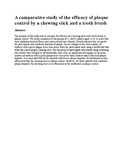| dc.contributor.author | Ndung'u, F L | |
| dc.contributor.author | Kaimenyi Jacob T. | |
| dc.contributor.author | Arneberg, P | |
| dc.contributor.author | Muthami, L N | |
| dc.date.accessioned | 2013-04-29T10:20:46Z | |
| dc.date.available | 2013-04-29T10:20:46Z | |
| dc.date.issued | 1990 | |
| dc.identifier.citation | East Afr Med J. 1990 Dec;67(12):907-11 | en |
| dc.identifier.uri | http://www.ncbi.nlm.nih.gov/pubmed/2083526 | |
| dc.identifier.uri | http://erepository.uonbi.ac.ke:8080/xmlui/handle/123456789/17620 | |
| dc.description.abstract | The purpose of this study was to compare the efficacy of a chewing stick and a tooth brush in plaque control. The study composed of two groups of 11 and 8 children aged 13 to 16 years who were randomly selected from a peri-urban school near Nairobi. Results showed that, except for the participants with moderate amounts of plaque, the net changes in the mean number of surfaces with a given plaque score were more when the participants were using a toothbrush than when they were using a chewing stick. For the group of participants who started using a chewing stick before they changed to the toothbrush, there were no significant net changes in the mean number of surfaces with a given plaque score except for those surfaces which had mild plaque deposits. It is concluded that for the patients with severe plaque deposits, the toothbrush is more efficacious than the chewing stick in plaque control. However, for those patients with moderate plaque deposits, the chewing stick is as efficacious as the toothbrush in plaque control. | en |
| dc.language.iso | en | en |
| dc.title | A comparative study of the efficacy of plaque control by a chewing stick and a tooth brush | en |
| dc.type | Article | en |
| local.publisher | Department of Dental Surgery, College of Health Sciences, Nairobi | en |

